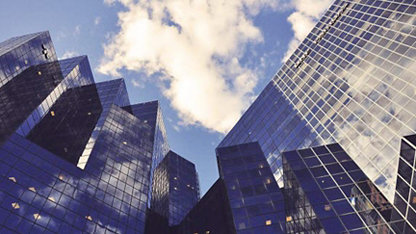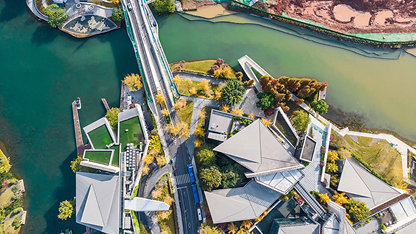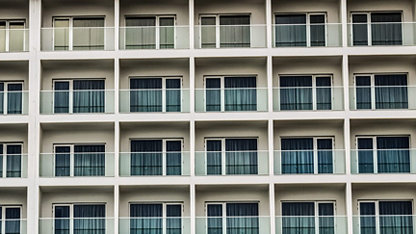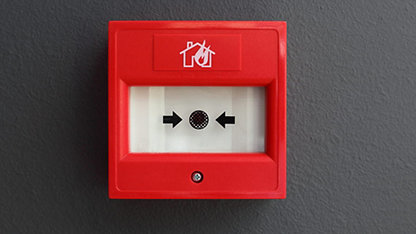A new technology
While the concept of self-healing concrete is a recent development, its roots can be traced back over two millennia to the Romans, who invented a unique type of concrete that displayed exceptional longevity and resilience, even in marine environments. This extraordinary material, used in iconic structures such as the Pantheon, owes its self-healing properties to the inclusion of volcanic ash and quicklime. The hot mixing of quicklime created lime-casts with a brittle nanoparticulate architecture. When cracks appeared, water infiltrated these particles, resulting in recrystallisation, which effectively ‘healed’ the concrete. This ancient engineering offers inspiration for modern-day self-healing concrete.
Today, self-healing concrete is achieved through the incorporation of specific materials, such as capsules containing healing agents. When cracks occur, these capsules release the healing agent, which reacts with water and air to form a solid material, effectively sealing the cracks and restoring the integrity of the concrete. This remarkable process bears resemblance to the natural regeneration of human bones, where new tissue grows to repair fractures.
The concept of self-healing concrete is relatively new and is still under research in most parts of the world, including the UK. But there have been many successful trials of this new technology in laboratories as well as real-world applications. Basilisk, a Dutch startup that specialises in the development of self-healing concrete solutions for infrastructure projects, has successfully used self-healing concrete in several commercial projects. For example, they extended the lifespan of a bus lane by 15 years using their product, Basilisk Liquid Repair System ER7. Situated in Schiphol Airport, the bus lane was showing a large number of cracks along the entire route. In order to save costs and prevent further damage to the concrete and reinforcements, Basilisk ER7 was applied, resulting in:
- ‘Life cycle cost reduction of approximately 33%
- More than 90% reduction on CO2 emissions
- Design life extended by a minimum of 15 years
- Less downtime’.
What is the process?
Sensicon, a partner of Basilisk, also produces a self-healing concrete, Sensicrete. The product was invented by Henk Jonkers, a microbiologist and professor at Delft University of Technology. It can be used in any concrete structure that is susceptible to water or moisture exposure, for example, concrete tunnels and sea defence walls. Sensicrete is made from a standard concrete mix with a self-healing agent added to it. The agent contains a dormant bacterium; once cracks appear and the bacteria come into contact with water, they produce limestone and seal the cracks. The exact healing process is shown below.
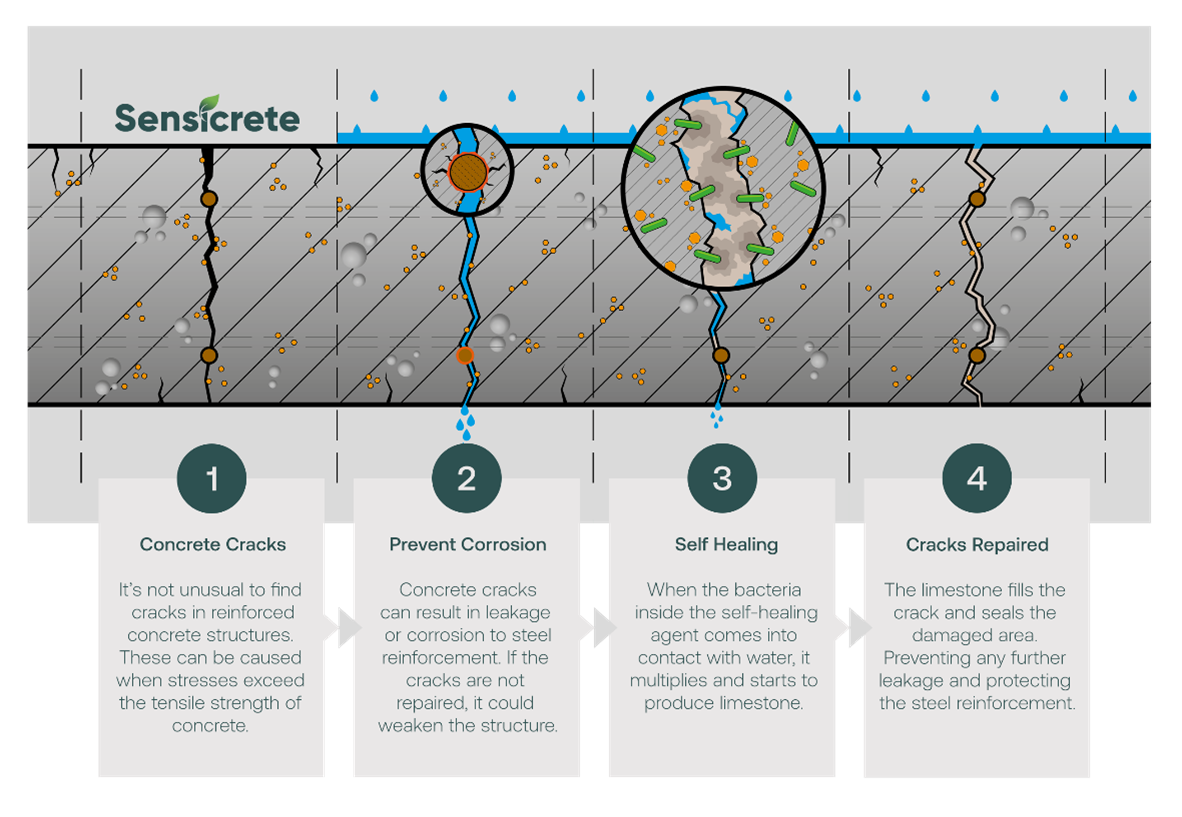
When can it be used?
Self-healing concrete can replace mainstream concrete in all types of construction projects. At a smaller scale, residential properties in towns and villages tend to be built using concreate foundations, usually in the form of columns or slabs. In such cases, self-healing concrete could increase the building lifespan. At a larger scale, self-healing concrete could be used in the construction of bridges and roads. These types of infrastructure bear heavy loads and therefore are much more susceptible to cracks. Replacing the concrete could significantly reduce maintenance costs while also increasing safety.
The numerous benefits of self-healing concrete
Increased lifespan
Self-healing concrete offers a multitude of benefits that contribute to its extended lifespan and sustainability. By effectively sealing cracks and preventing air leakage, self-healing concrete enhances insulation capabilities, leading to significant energy savings. This not only improves indoor comfort but also reduces the ecological footprint associated with heating and cooling.
Moreover, the durability of self-healing concrete reduces the reliance on additional materials during construction. Its enhanced strength minimises the need for resource-intensive steel rebars, lowering demand for production processes with high environmental impact. Additionally, the self-healing properties eliminate the need for sealants to repair cracks, reducing material consumption and waste generation. These combined advantages promote a more efficient use of resources and a reduced environmental impact throughout the construction process.
Reduced carbon emissions
The production of concrete is a significant contributor to global CO2 emissions, accounting for 7% of all emissions, with 2.6 billion metric tons of embodied carbon emitted in 2021. While self-healing concrete may not eliminate these emissions entirely, it does offer substantial reductions.
With the lifespan extended due to the ability to repair cracks, the carbon emissions associated with producing additional concrete are reduced. Sensicon states that their products can lead to a reduction of 30–40% maintenance due to increased water tightness. Therefore, carbon emissions related to maintenance will be reduced throughout the structure's lifespan, which can directly contribute towards significant cost savings.
Cement, a key component of traditional concrete, is a major contributor to carbon emissions due to its energy-intensive production process. Self-healing concrete addresses this issue by incorporating other materials, such as bacteria that can produce limestone to fill cracks, reducing the amount of cement required. This innovative approach significantly reduces the embodied carbon within the material, making it more environmentally friendly.
Furthermore, steel used as reinforcement in concrete structures is another significant source of carbon emissions. Self-healing concrete not only improves the tensile strength of the material, reducing the likelihood of cracking, but also helps protect the steel from corrosion. By minimising the need for steel rebars and safeguarding against corrosion, self-healing concrete reduces the environmental impact associated with steel production. According to Sensicon, structures that use self-healing concrete can achieve reductions of up to 72kg of CO2 through decreased cement and steel usage.
Enhanced safety
Self-healing concrete offers numerous safety enhancements, providing a reliable and secure solution for construction projects. One of the key safety benefits is the reduction of risk related to structural collapse. By healing minor cracks before they can compromise a building's integrity, self-healing concrete ensures a structure’s long-term stability and safety. In traditional concrete structures, the presence of cracks allows water and corrosive substances to reach the steel rebars, leading to corrosion and weakening of the structure. However, self-healing concrete not only reduces the need for steel rebars but also proactively repairs cracks, minimising the chances of corrosive liquids coming into contact with the rebars.
Certain types of self-healing concrete are being developed to incorporate fire-retardant materials, further improving the fire resistance of buildings. One such example, being developed by Stevens Institute of Technology, is a material known as a multifunctional cementitious composite. This innovative approach helps limit the spread of fire and minimises damage in the event of a fire, enhancing the safety of occupants and neighbouring structures. By reducing a fire's impact, self-healing concrete will play a vital role in safeguarding lives and property.
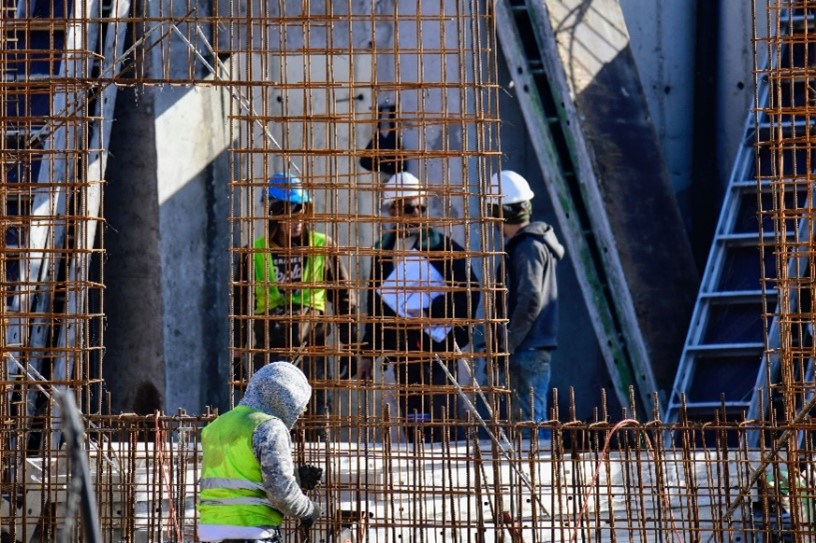
How much does it cost?
The cost of self-healing concrete can vary depending on certain factors, such as the type of technology implemented, the scale and complexity of a project and market demand. Currently, costs are fairly high, totalling almost twice the cost of normal concrete due to the added cost of the self-healing mechanisms. Like all types of technology, prices will remain high until it starts being used at a commercial scale.
A promising future
The future of self-healing concrete looks promising. As more research and development is conducted, advancements in materials and manufacturing processes are expected to drive down costs and make self-healing concrete more commercially viable. With an increasing focus on sustainable construction practices and the need for durable infrastructure, self-healing concrete has the potential to revolutionise the way we build and maintain structures. At present, while there is plenty of information available about the benefits and availability of self-healing concrete, there appears to be a reluctance by project sponsors, architects, civil engineers, contractors, and others to start using the material, even for small elements of projects to understand the benefits on a whole life cost and emissions basis.
Self-healing concrete represents a significant advancement in construction technology, with the potential to revolutionise the industry. By drawing inspiration from ancient engineering wisdom and harnessing the principles of nature, this innovative material offers a sustainable, eco-friendly and durable solution for infrastructure and building projects. With its capacity to repair cracks, reduce maintenance costs, minimise carbon emissions and enhance structural safety, self-healing concrete could help to shape a future where our built environment is resilient. As research and development progress, and costs become more competitive, the widespread adoption of self-healing concrete as a standard practice seems imminent, bringing us closer to a more sustainable and durable future for construction.


